Uncategorized
Crypto Daybook Americas: Trump’s Reserve Rumors Swirl as BTC Rebound Eyes $95K

By Omkar Godbole (All times ET unless indicated otherwise)
The crypto market has stabilized somewhat following comments from Commerce Minister Howard Lutnick, who said President Donald Trump could announce on Wednesday a pathway for tariff relief on Canadian and Mexican imports covered by NAFTA.
That has helped BTC bounce to nearly $90K, with the total crypto market cap rising to the $2.9 trillion mark. The recovery could extend further as the recent trade war fears and market volatility have reignited bets on Federal Reserve (Fed) rate cuts.
According to CME’s FedWatch tool, the market is now pricing in at least three rate cuts for this year, while the 10-year Treasury yield has retreated to 4.15%, down from 4.80% at the time of Trump’s inauguration. Meanwhile, Germany’s decision to abandon its fiscal constraints has led to soaring bond yields, prompting a sell-off in the dollar index that could encourage risk-taking in the market.
As a result, there is a chance that bitcoin may revisit its weekend high of $95,000, particularly as technical charts indicate signs of seller exhaustion.
However, worsening growth concerns could limit these gains. Just two days ago, the Atlanta Fed’s GDP forecast turned negative at -2.8%, raising fears of stagflation, as noted by Singapore-based QCP Capital. The firm stressed the importance of monitoring corporate yield spreads—both high-yield and investment-grade bonds—in relation to U.S. Treasury yields for signs of market stress. «While this isn’t signaling panic right now, it’s a trend worth monitoring closely,» QCP said in a Telegram broadcast.
An important consideration is how much of the decline in the 10-year yield and the weakness in the dollar can be attributed to traders adjusting their expectations about U.S. economic exceptionalism, which was largely based on Biden era’s fiscal splurge. Given the rise of ETFs and Trump’s pro-crypto stance, bitcoin has become more of a U.S. play, and a shift in the U.S. exceptionalism narrative could lead to BTC volatility.
JPMorgan, however, foresees strengthening of the U.S. exceptionalism narrative under Trump’s Presidency.
All of this means that Wednesday’s U.S. ISM non-manufacturing (services) PMI and Friday’s nonfarm payrolls could significantly influence the crypto markets.
There are also rumors that President Trump will unveil the crypto reserve strategy at the White House Crypto Summit this Friday. With Trump having made considerable promises, the markets will be watching closely to see if he delivers; otherwise, there could be further turmoil ahead. Stay alert!
What to Watch
Crypto:
March 5, 11:00 a.m.: Circle hosts a live webinar titled “State of the USDC Economy 2025” featuring Circle Chief Strategy Officer and Head of Global Policy Dante Disparte and three other executives from Bridge, Nubank and Cumberland.
March 6: Ethereum-based L2 blockchain MegaETH deploys its public testnet, with user onboarding starting on March 10.
March 7: President Trump will host the inaugural White House Crypto Summit, bringing together top cryptocurrency founders, CEOs and investors.
March 11: The Bitcoin Policy Institute and U.S. Senator Cynthia Lummis co-host the invitation-only one-day event «Bitcoin for America» in Washington.
March 12: Hemi, an L2 blockchain that operates on both Bitcoin and Ethereum, has its mainnet launch.
Macro
March 5, 8:00 a.m.: S&P Global releases February Brazil economic activity data.
Services PMI Prev. 47.6
Composite PMI Prev. 48.2
March 5, 8:15 a.m.: Automatic Data Processing (ADP) releases February U.S. non-farm private sector employment data.
ADP Employment Change Est. 140K vs. Prev. 183K
March 5, 9:30 a.m.: S&P Global releases February Canada economic activity data.
Services PMI Prev. 49
Composite PMI Prev. 49.5
March 5, 9:45 a.m.: S&P Global releases February U.S. economic activity data.
Services PMI Est. 49.7 vs. Prev. 52.9
Composite PMI Est. vs. 50.4 vs. Prev. 52.7
March 5, 10:00 a.m.: Institute for Supply Management (ISM) releases February U.S. economic activity data.
Services PMI Est. 52.6 vs. Prev. 52.8
Earnings (Ests. based on FactSet data)
March 6 (TBC): Bitfarms (BITF), $-0.06
March 17 (TBC): Bit Digital (BTBT), $-0.05
March 18 (TBC): TeraWulf (WULF), $-0.04
March 24 (TBC): Galaxy Digital Holdings (TSE: GLXY), C$0.39
Token Events
Governance votes & calls
Paraswap DAO is discussing the return of 44.67 wrapped ether (wETH) to hacked cryptocurrency exchange Bybit that were collected by the DAO since the security breach.
Morpho DAO is voting on adjusting MORPHO token rewards on various networks by granting the Morpho Association the ability to alter rewards within predefined limits.
Aave DAO is discussing the introduction of sGHO, a yield-bearing token that allows users to earn the Aave Savings Rate (ASR) by depositing GHO stablecoins.
March 5, 8 a.m.: Aptos and MEXC to hold an Ask Me Anything (AMA) session.
March 5, 9 a.m.: Next to hold a Product Lounge: Markets Edition AMA session.
March 5, 11 a.m.: Circle to host a call on The State of the USDC Economy.
March 5, 12 p.m.: Wormhole to hold an Ecosystem Call.
March 6, 8:30 a.m.: GMX to hold a Governance Community Call for the GMX DAO.
Unlocks
March 7: Kaspa (KAS) to unlock 0.63% of circulating supply worth $12.68 million.
March 9: Movement (MOVE) to unlock 2.08% of its circulating supply worth $20.85 million.
March 12: Aptos (APT) to unlock 1.93% of circulating supply worth $67.41 million.
March 15: Starknet (STRK) to unlock 2.33% of its circulating supply worth $11.88 million.
March 15: Sei (SEI) to unlock 1.19% of its circulating supply worth $12.76 million.
March 16: Arbitrum (ARB) to unlock 2.1% of its circulating supply worth $37.03 million.
Token Listings
March 5: Just (JST) to be listed on HashKey
March 6: Roam (ROAM) to be listed on KuCoin and MEXC.
Conferences
CoinDesk’s Consensus is taking place in Toronto on May 14-16. Use code DAYBOOK and save 15% on passes.
Day 2 of 4: FIN/SUM 2025 (Tokyo)
March 8: Bitcoin Alive (Sydney)
March 10-11: MoneyLIVE Summit (London)
March 13-14: Web3 Amsterdam ‘25
March 19-20: Next Block Expo (Warsaw, Poland)
March 25-27: Mining Disrupt (Fort Lauderdale, Fla.)
March 26: DC Blockchain Summit 2025 (Washington)
March 28: Solana APEX (Cape Town, South Africa)
Token Talk
By Shaurya Malwa
Berachain’s ‘first’ memecoin HENLO goes live, racking up a $26 million market cap shortly after issuance.
HENLO is a community-driven memecoin on Berachain, created by The Honey Jar collective, focusing on humor and engagement with no explicit utility.
It raised $3 million in a February 2025 seed round, backed by Framework Ventures and other VCs.
It offers staking, DEX trading, and yield farming on Berachain’s mainnet, with Henlo ‘points’ to reward early adopters.
Aims to enhance utility with staking and governance, expand partnerships, refine tokenomics (with a 100 billion total supply), and grow its community through events and airdrops.
Derivatives Positioning
Positioning in BTC and ETH CME futures remains light despite signs of market stability, leaving the basis near 6%.
BTC, ETH perpetual funding rates are marginally positive, indicating continued caution among traders.
BCH leads the majors in terms of price and open interest gains, but the flat 24-hour cumulative volume delta questions the sustainability of the price surge.
BTC risk reversals show a bias for puts in mid-March and end-of-the-month expiries. The pricing flips decisively bullish in favor of calls only after the April expiry. ETH options show a similar story.
Market Movements:
BTC is up 2.85% from 4 p.m. ET Tuesday at $90,063.44 (24hrs: +6.98%)
ETH is up 2.82% at $2,240.32 (24hrs: +6.11%)
CoinDesk 20 is down 4.37% at 2,938.93 (24hrs: +7.8%)
Ether CESR Composite Staking Rate is up 29 bps at 3.36%
BTC funding rate is at -0.0007% (-0.25% annualized) on Binance
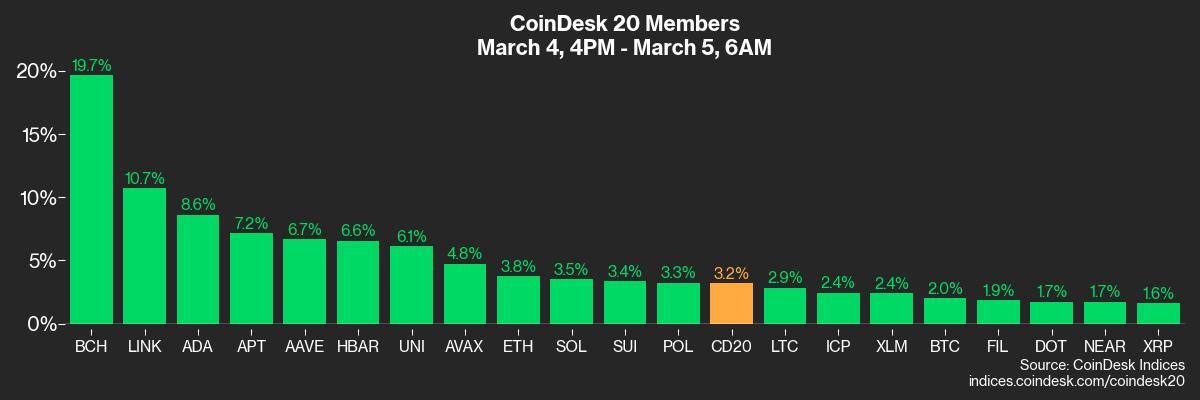
DXY is down 0.69% at 105.01
Gold is up 0.57% at $2926.20/oz
Silver is up 2.58% at $32.94/oz
Nikkei 225 closed +0.23% at 37,418.24
Hang Seng closed +2.84% at 23,594.21
FTSE is up 0.6% at 8,811.13
Euro Stoxx 50 is up 2.45% at 5,519.47
DJIA closed on Tuesday -1.55% at 42,520.99
S&P 500 closed -1.22% at 5,778.15
Nasdaq closed -0.35% at 18,285.16
S&P/TSX Composite Index closed -1.72% at 24,572.00
S&P 40 Latin America closed unchanged at 2,286.69
U.S. 10-year Treasury rate is unchanged at 4.25%
E-mini S&P 500 futures are up 0.66% at 5,828.00
E-mini Nasdaq-100 futures are up 0.81% at 20,564.00
E-mini Dow Jones Industrial Average Index futures are up 0.58% at 42,840.00
Bitcoin Stats:
BTC Dominance: 61.29 (0.03%)
Ethereum to bitcoin ratio: 0.02500 (0.48%)
Hashrate (seven-day moving average): 808 EH/s
Hashprice (spot): $49.6
Total Fees: 5.24 BTC / $444,853
CME Futures Open Interest: 139,245 BTC
BTC priced in gold: 30.7 oz
BTC vs gold market cap: 8.72%
Technical Analysis
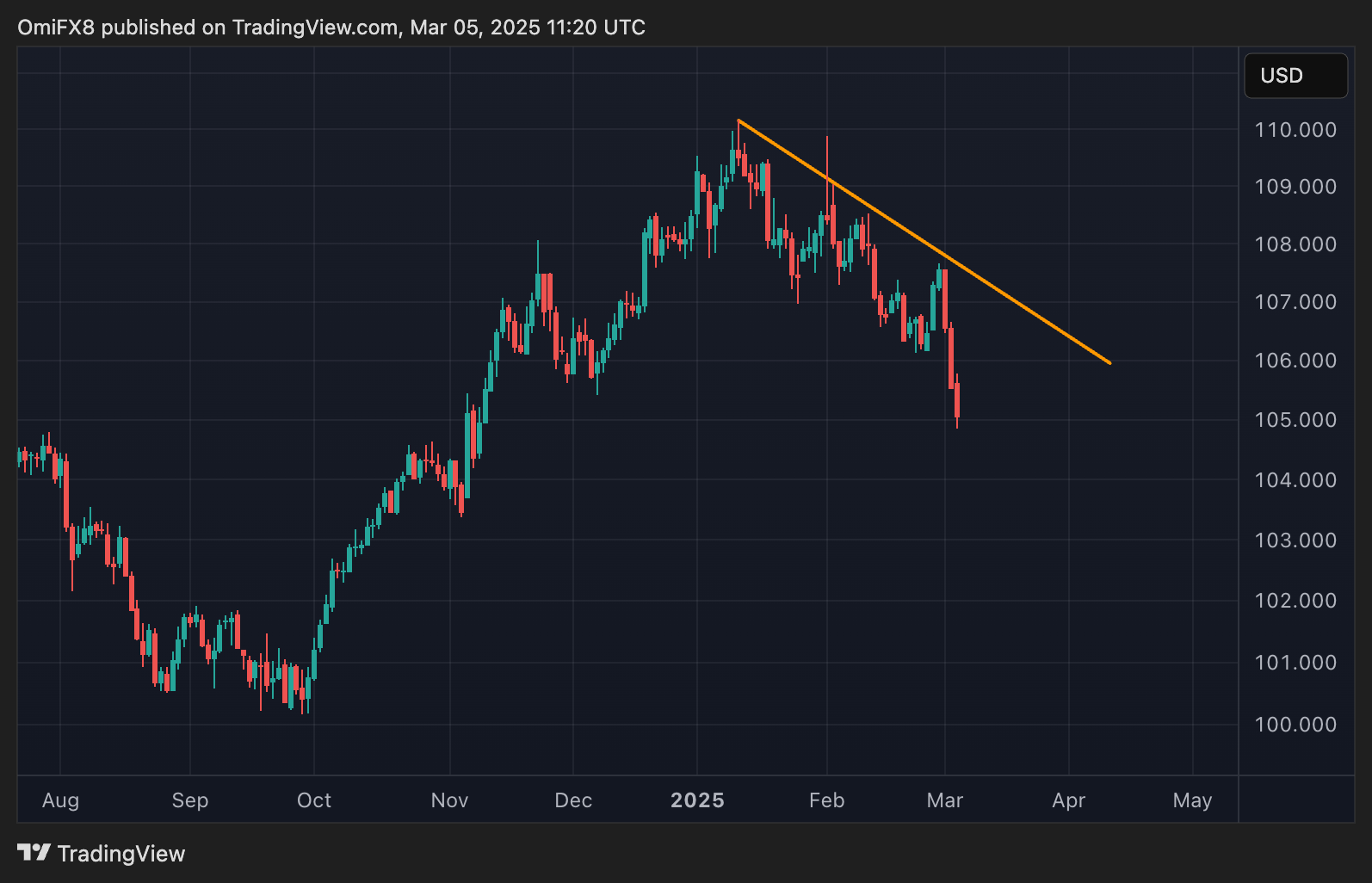
The dollar index, which tracks the greenback’s value against major currencies, has dropped to the lowest since November, establishing a proper downtrend on the daily chart.
With the German-U.S.- bond yield spread widening in the EUR-positive manner, further losses in the DXY can be expected.
Weakness in the DXY generally bodes well for riskier assets.
Crypto Equities
MicroStrategy (MSTR): closed on Tuesday at $275.15 (+9.66%), up 3.83% at $285.80 in pre-market
Coinbase Global (COIN): closed at $212.55 (+3.3%), up 2.34% at $217.53
Galaxy Digital Holdings (GLXY): closed at C$19.04 (-8.29%)
MARA Holdings (MARA): closed at $13.97 (+1.31%), up 4.58% at $14.61
Riot Platforms (RIOT): closed at $8.41(-5.08%), up 4.28% at $8.77
Core Scientific (CORZ): closed at $9.59 (-5.42%), up 5.74% at $10.14
CleanSpark (CLSK): closed at $7.76 (-0.39%), up 4.64% at $8.12
CoinShares Valkyrie Bitcoin Miners ETF (WGMI): closed at $16.26 (-1.45%), up 5.1% at $17.09
Semler Scientific (SMLR): closed at $38.36 (-1.36%), up 4.14% at $39.95
Exodus Movement (EXOD): closed +3.69% at $42.48
ETF Flows
Spot BTC ETFs:
Daily net flow: -$143.5 million
Cumulative net flows: $36.73 billion
Total BTC holdings ~ 1,139 million.
Spot ETH ETFs
Daily net flow: $14.6 million
Cumulative net flows: $2.82 billion
Total ETH holdings ~ 3.649 million.
Source: Farside Investors
Overnight Flows
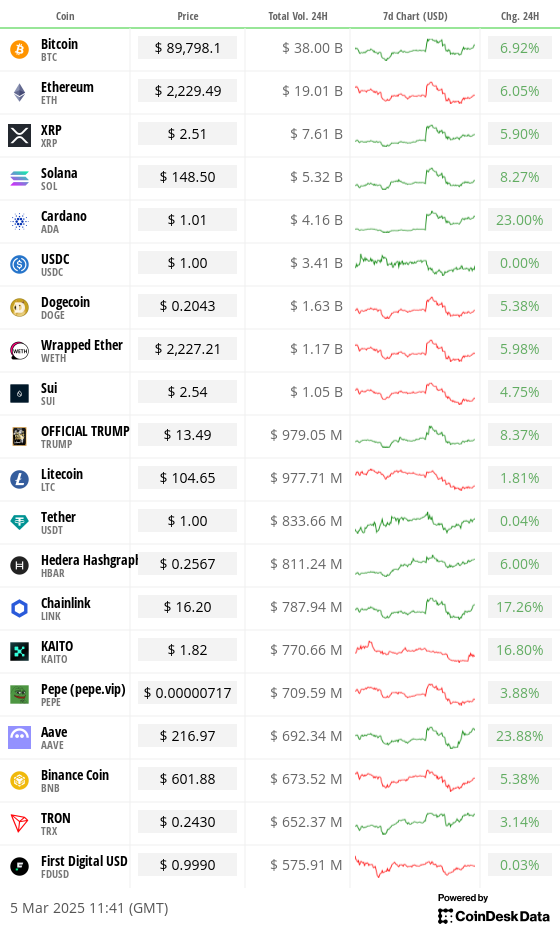
Chart of the Day
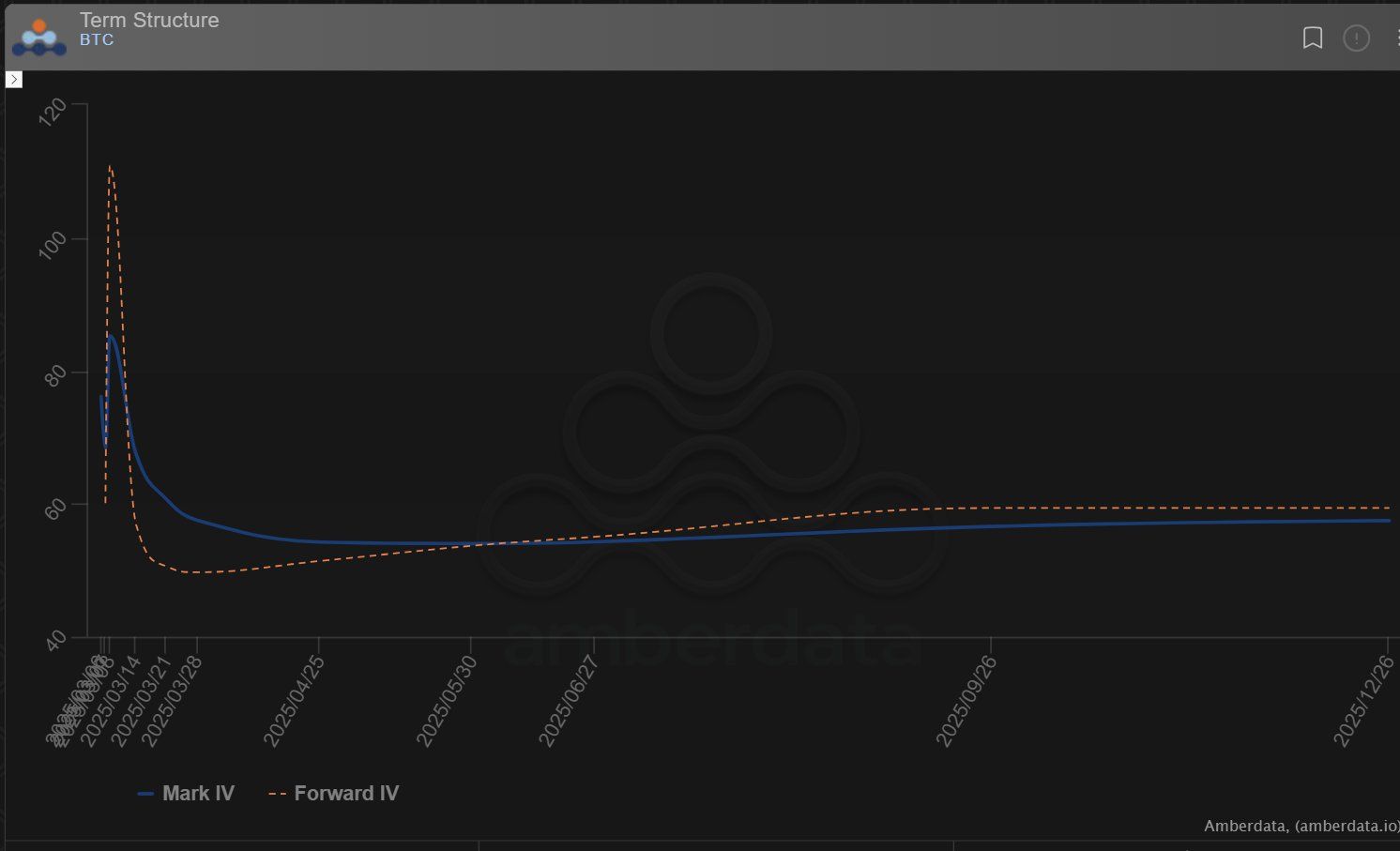
The chart shows bitcoin’s options-based implied volatility term structure, a graphical representation of implied or expected volatilities at different expirations.
Both forward IV and mark IV show a big bump higher on March 8, a sign that traders expect Trump’s comments at Friday’s White House Crypto summit to lead to volatile market conditions.
While You Were Sleeping
Metaplanet Buys 497 BTC in Another Bargain-Hunting Bitcoin Acquisition (CoinDesk): Japan’s Metaplanet announced Wednesday that its latest bitcoin purchase, acquired at $88,448 per BTC, brings its total holdings to 2,888 BTC.
BlackRock’s Bitcoin ETF Registers Highest Trading Volume in 3 Months (CoinDesk): As BlackRock’s spot Bitcoin ETF (IBIT) price declined last week, trading volume hit its highest level since mid-November, according to TradingView data.
AAVE Jumps 21% as Aave DAO Reveals its ‘Most Important’ Proposal (CoinDesk): On Tuesday, Aave DAO proposed a plan to boost AAVE token value and reward users, including increased staking benefits, a buyback program, and protections against market downturns.
Key Moments From Donald Trump’s Address to Congress (Financial Times): In a Tuesday night address to Congress, Trump pledged to bring Greenland into the U.S., called for ending the Russia-Ukraine war, and praised Elon Musk’s push to cut government waste.
China Targets ‘Around 5%’ Growth in 2025 and Lays Out Stimulus Measures As Trade Worries Mount (CNBC): At its annual legislative meeting, China set a 2025 budget deficit target of 4% of GDP and lowered its consumer inflation target to around 2%.
Dollar Falls on Fears Over U.S. Outlook (The Wall Street Journal): The dollar slid to a 16-week low, with the DXY index at 105.252, as concerns over U.S. economic weakness, trade policy turmoil, and inflation weighed on investor confidence, Pepperstone’s Michael Brown said.
In the Ether
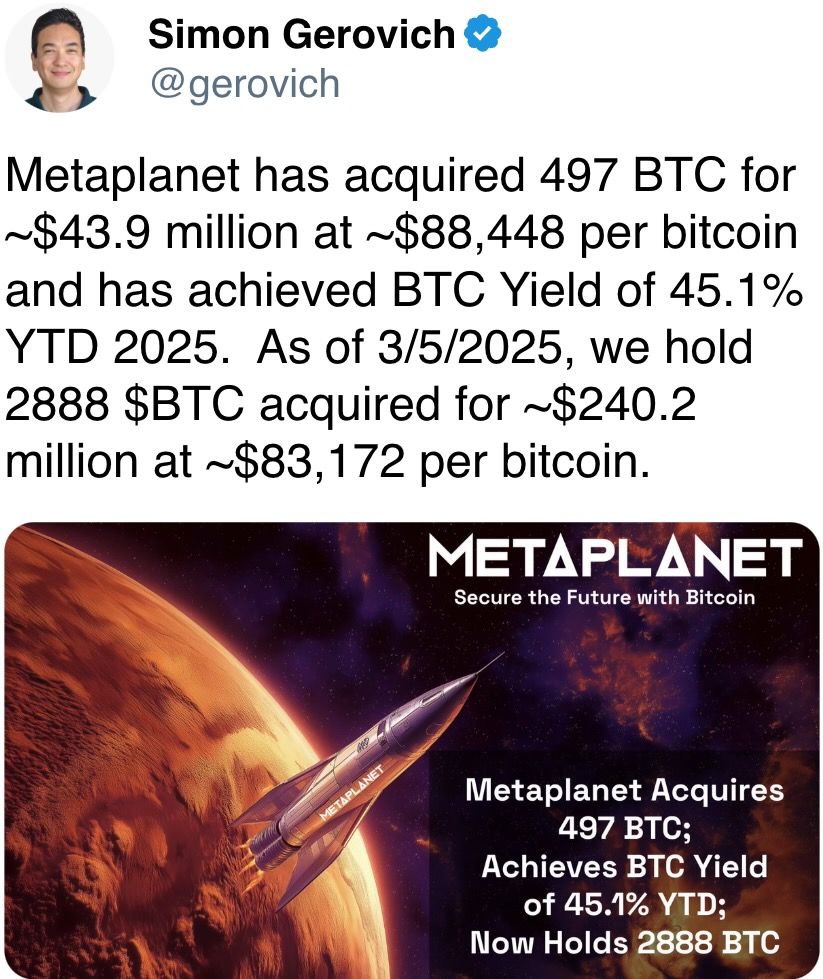
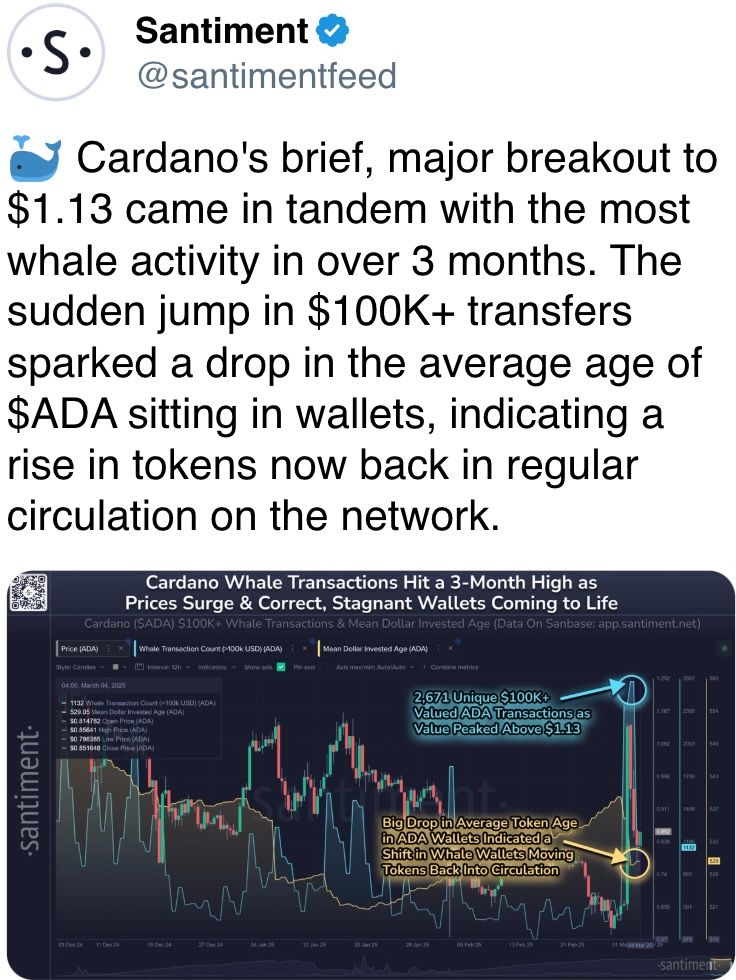

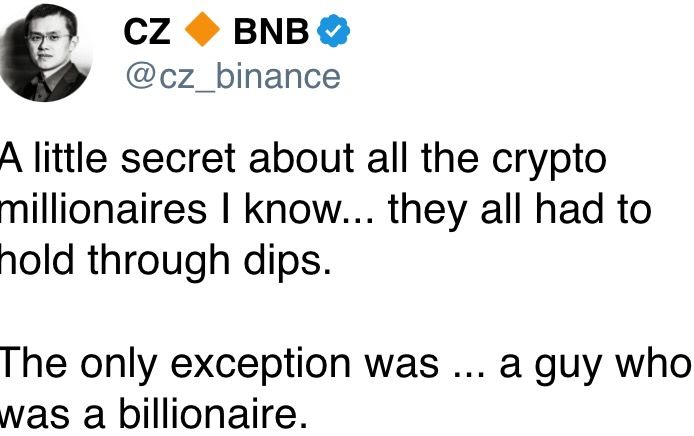

Uncategorized
Asia Morning Briefing: Fragility or Back on Track? BTC Holds the Line at $115K

Good Morning, Asia. Here’s what’s making news in the markets:
Welcome to Asia Morning Briefing, a daily summary of top stories during U.S. hours and an overview of market moves and analysis. For a detailed overview of U.S. markets, see CoinDesk’s Crypto Daybook Americas.
Bitcoin (BTC) traded just above $115k in Asia Tuesday morning, slipping slightly after a strong start to the week.
The modest pullback followed a run of inflows into U.S. spot ETFs and lingering optimism that the Federal Reserve will cut rates next week. The moves left traders divided: is this recovery built on fragile foundations, or is crypto firmly back on track after last week’s CPI-driven jitters?
That debate is playing out across research desks. Glassnode’s weekly pulse emphasizes fragility. While ETF inflows surged nearly 200% last week and futures open interest jumped, the underlying spot market looks weak.
Buying conviction remains shallow, Glassnode writes, funding rates have softened, and profit-taking is on the rise with more than 92% of supply in profit.
Options traders have also scaled back downside hedges, pushing volatility spreads lower, which Glassnode warns leaves the market exposed if risk returns. The core message: ETFs and futures are supporting the rally, but without stronger spot flows, BTC remains vulnerable.
QCP takes the other side.
The Singapore-based desk says crypto is “back on track” after CPI confirmed tariff-led inflation without major surprises. They highlight five consecutive days of sizeable BTC ETF inflows, ETH’s biggest inflow in two weeks, and strength in XRP and SOL even after ETF delays.
Traders, they argue, are interpreting regulatory postponements as inevitability rather than rejection. With the Altcoin Season Index at a 90-day high, QCP sees BTC consolidation above $115k as the launchpad for rotation into higher-beta assets.
The divide underscores how Bitcoin’s current range near $115k–$116k is a battleground. Glassnode calls it fragile optimism; QCP calls it momentum. Which side is right may depend on whether ETF inflows keep offsetting profit-taking in the weeks ahead.
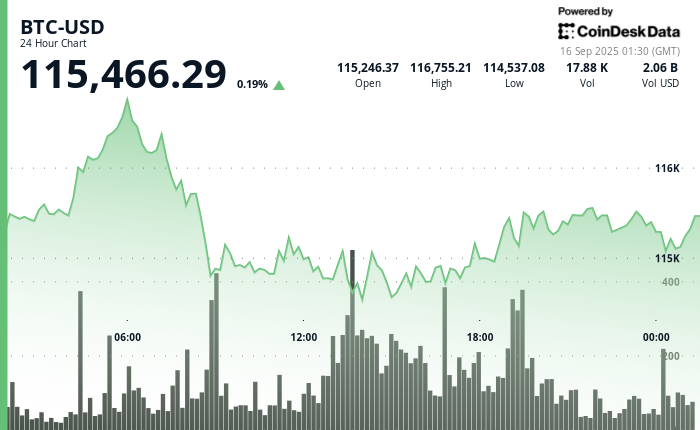
Market Movement
BTC: Bitcoin is consolidating near the $115,000 level as traders square positions ahead of expected U.S. Fed policy moves; institutional demand via spot Bitcoin ETFs is supporting upside
ETH: ETH is trading near $4500 in a key resistance band; gains are being helped by renewed institutional demand, tightening supply (exchange outflows), and positive technical setups.
Gold: Gold continues to hold near record highs, underpinned by expectations of Fed interest rate cuts, inflation risk, and investor demand for safe havens; gains tempered somewhat by profit‑taking and a firmer U.S. dollar
Nikkei 225: Japan’s Nikkei 225 topped 45,000 for the first time Monday, leading Asia-Pacific gains as upbeat U.S.-China trade talks and a TikTok divestment framework lifted sentiment.
S&P 500: The S&P 500 rose 0.5% to close above 6,600 for the first time on Monday as upbeat U.S.-China trade talks and anticipation of a Fed meeting lifted stocks.
Elsewhere in Crypto
Uncategorized
Wall Street Bank Citigroup Sees Ether Falling to $4,300 by Year-End

Wall Street giant Citigroup (C) has launched new ether (ETH) forecasts, calling for $4,300 by year-end, which would be a decline from the current $4,515.
That’s the base case though. The bank’s full assessment is wide enough to drive an army regiment through, with the bull case being $6,400 and the bear case $2,200.
The bank analysts said network activity remains the key driver of ether’s value, but much of the recent growth has been on layer-2s, where value “pass-through” to Ethereum’s base layer is unclear.
Citi assumes just 30% of layer-2 activity contributes to ether’s valuation, putting current prices above its activity-based model, likely due to strong inflows and excitement around tokenization and stablecoins.
A layer 1 network is the base layer, or the underlying infrastructure of a blockchain. Layer 2 refers to a set of off-chain systems or separate blockchains built on top of layer 1s.
Exchange-traded fund (ETF) flows, though smaller than bitcoin’s (BTC), have a bigger price impact per dollar, but Citi expects them to remain limited given ether’s smaller market cap and lower visibility with new investors.
Macro factors are seen adding only modest support. With equities already near the bank’s S&P 500 6,600 target, the analysts do not expect major upside from risk assets.
Read more: Ether Bigger Beneficiary of Digital Asset Treasuries Than Bitcoin or Solana: StanChart
Uncategorized
XLM Sees Heavy Volatility as Institutional Selling Weighs on Price
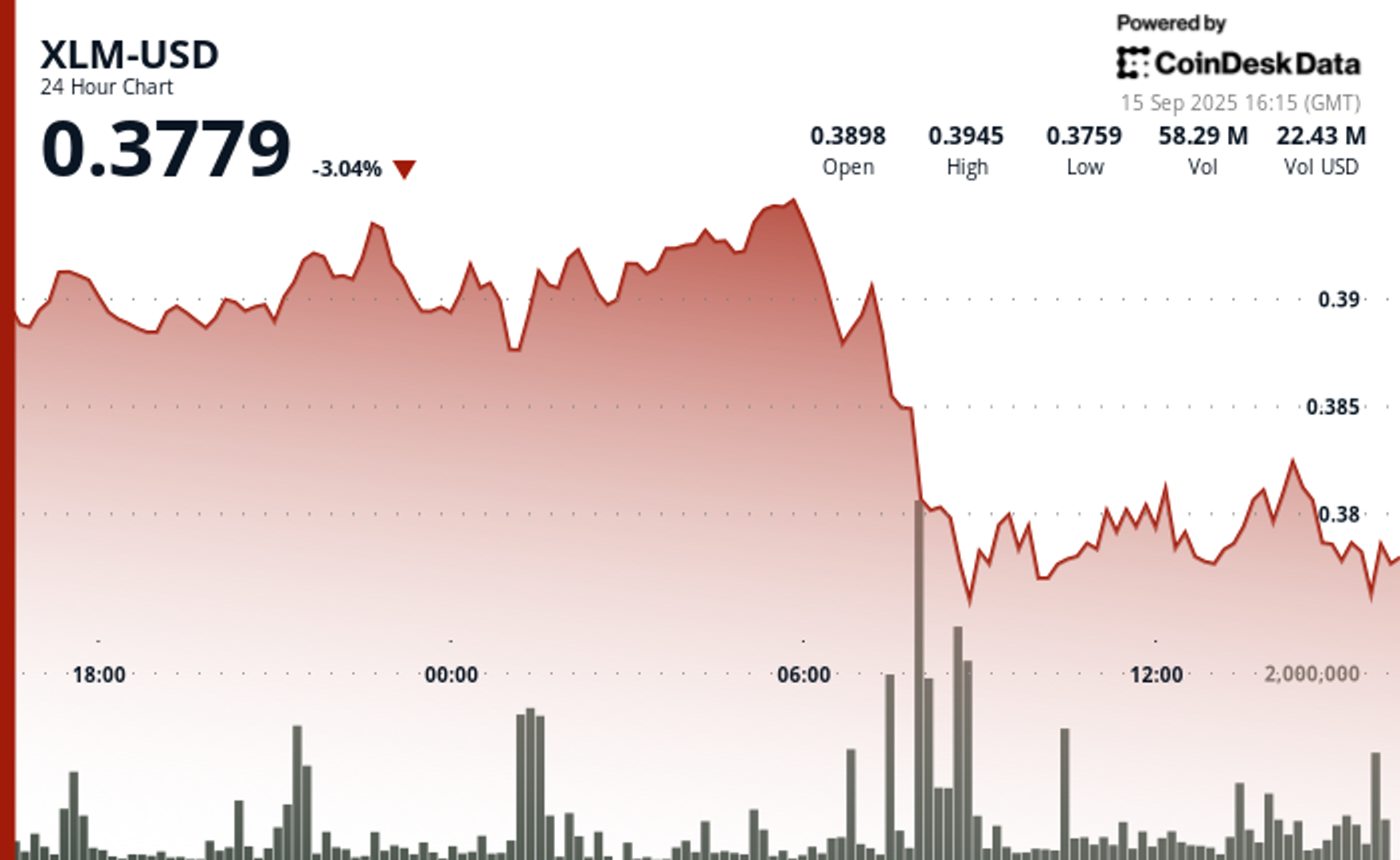
Stellar’s XLM token endured sharp swings over the past 24 hours, tumbling 3% as institutional selling pressure dominated order books. The asset declined from $0.39 to $0.38 between September 14 at 15:00 and September 15 at 14:00, with trading volumes peaking at 101.32 million—nearly triple its 24-hour average. The heaviest liquidation struck during the morning hours of September 15, when XLM collapsed from $0.395 to $0.376 within two hours, establishing $0.395 as firm resistance while tentative support formed near $0.375.
Despite the broader downtrend, intraday action highlighted moments of resilience. From 13:15 to 14:14 on September 15, XLM staged a brief recovery, jumping from $0.378 to a session high of $0.383 before closing the hour at $0.380. Trading volume surged above 10 million units during this window, with 3.45 million changing hands in a single minute as bulls attempted to push past resistance. While sellers capped momentum, the consolidation zone around $0.380–$0.381 now represents a potential support base.
Market dynamics suggest distribution patterns consistent with institutional profit-taking. The persistent supply overhead has reinforced resistance at $0.395, where repeated rally attempts have failed, while the emergence of support near $0.375 reflects opportunistic buying during liquidation waves. For traders, the $0.375–$0.395 band has become the key battleground that will define near-term direction.
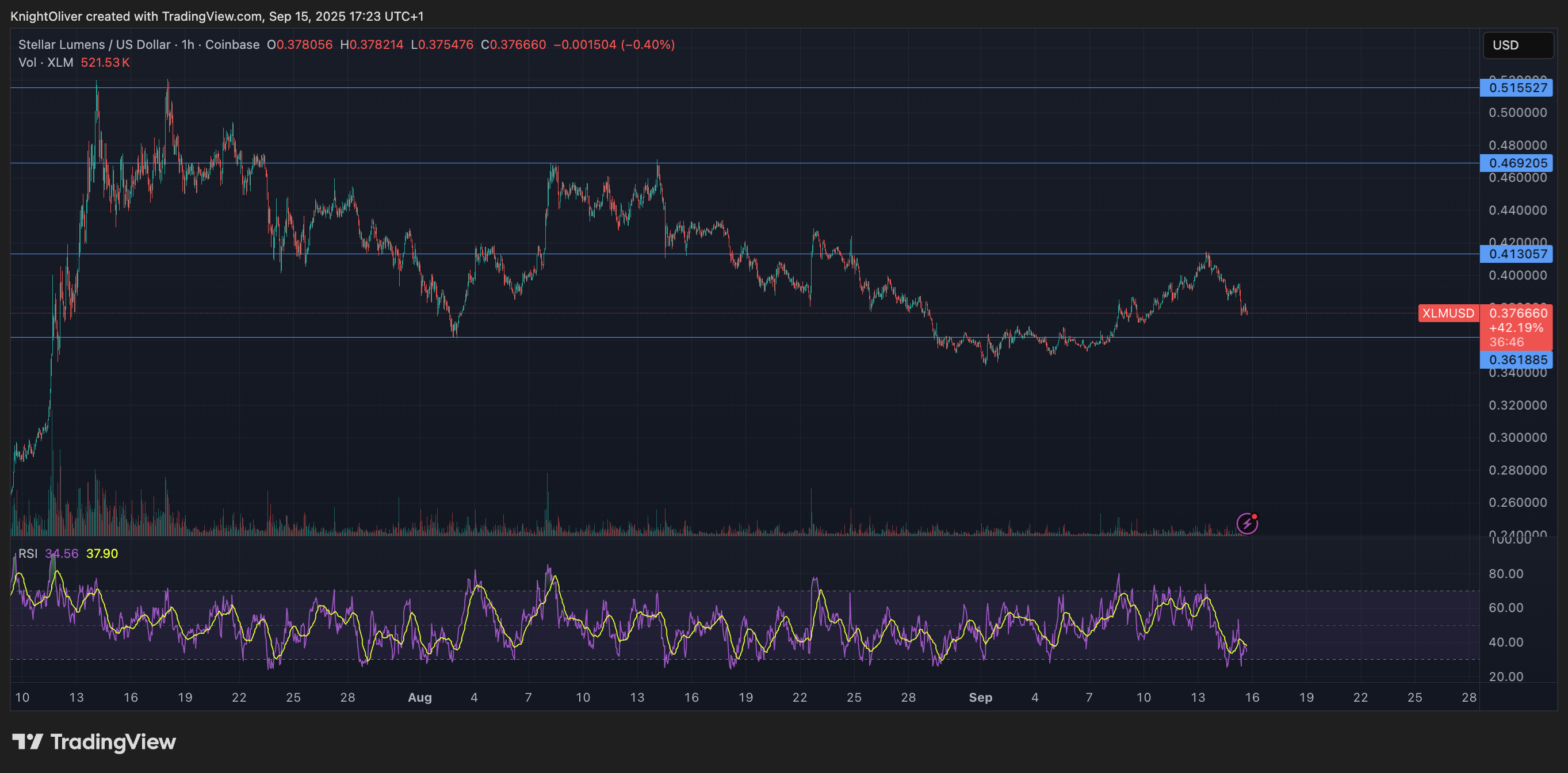
Technical Indicators
- XLM retreated 3% from $0.39 to $0.38 during the previous 24-hours from 14 September 15:00 to 15 September 14:00.
- Trading volume peaked at 101.32 million during the 08:00 hour, nearly triple the 24-hour average of 24.47 million.
- Strong resistance established around $0.395 level during morning selloff.
- Key support emerged near $0.375 where buying interest materialized.
- Price range of $0.019 representing 5% volatility between peak and trough.
- Recovery attempts reached $0.383 by 13:00 before encountering selling pressure.
- Consolidation pattern formed around $0.380-$0.381 zone suggesting new support level.
Disclaimer: Parts of this article were generated with the assistance from AI tools and reviewed by our editorial team to ensure accuracy and adherence to our standards. For more information, see CoinDesk’s full AI Policy.
-

 Business11 месяцев ago
Business11 месяцев ago3 Ways to make your business presentation more relatable
-

 Fashion11 месяцев ago
Fashion11 месяцев agoAccording to Dior Couture, this taboo fashion accessory is back
-

 Entertainment11 месяцев ago
Entertainment11 месяцев ago10 Artists who retired from music and made a comeback
-

 Entertainment11 месяцев ago
Entertainment11 месяцев ago\’Better Call Saul\’ has been renewed for a fourth season
-

 Entertainment11 месяцев ago
Entertainment11 месяцев agoNew Season 8 Walking Dead trailer flashes forward in time
-

 Business11 месяцев ago
Business11 месяцев ago15 Habits that could be hurting your business relationships
-

 Entertainment11 месяцев ago
Entertainment11 месяцев agoMeet Superman\’s grandfather in new trailer for Krypton
-

 Entertainment11 месяцев ago
Entertainment11 месяцев agoDisney\’s live-action Aladdin finally finds its stars





